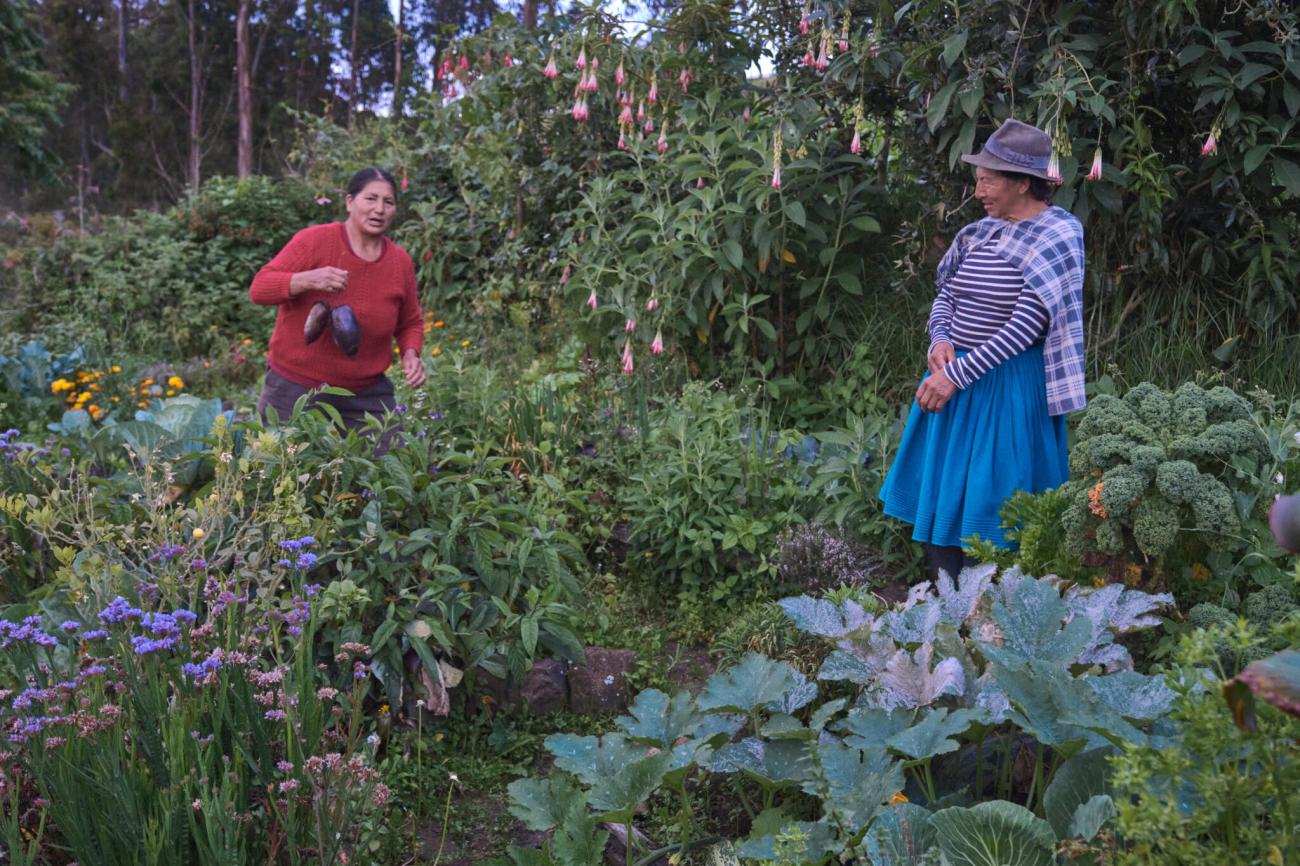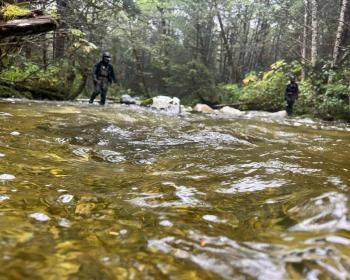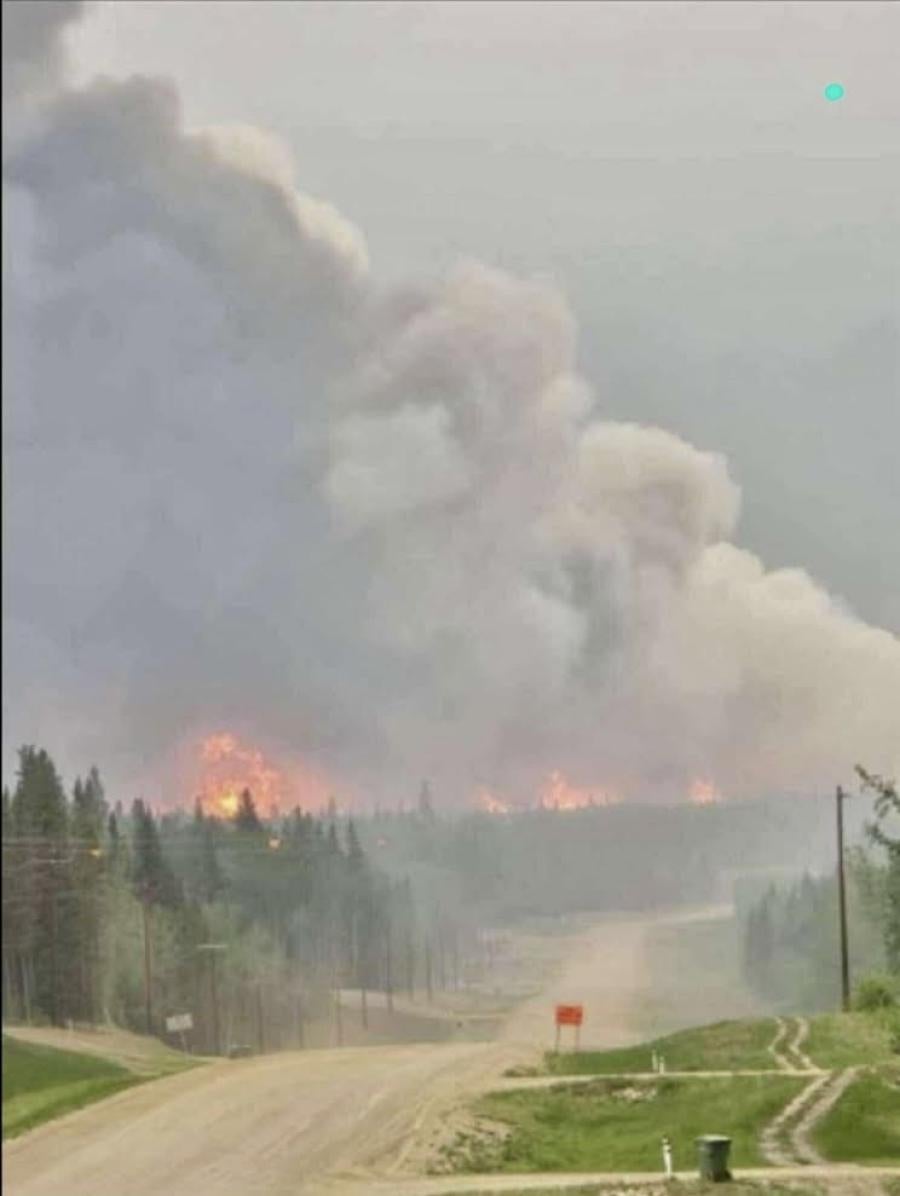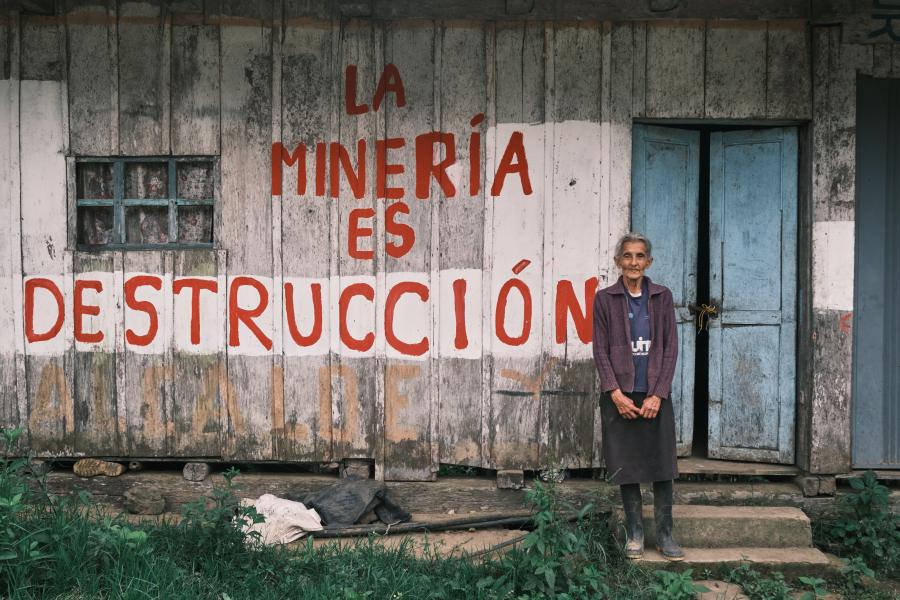
Over the past six months, Indigenous journalist Brandi Morin has travelled repeatedly to Ecuador, reporting on the impact of Canadian mining projects on the Indigenous Peoples who live there. Morin reports from the rolling hills outside the city of Cuenca, Ecuador, where Dundee Precious Metals, a Canadian company, plans to develop the underground Loma Larga gold mine.
By Brandi Morin (Iriquois, Cree)
In the heart of Cuenca, in an old house filled with books on faith, revolution, and Indigenous rights, lives Father Fernando Vega, an 80-year-old priest whose spiritual guidance has become a cornerstone of the water defense movement. With his snow-white hair slicked back and a simple gray sweater hanging from his angular shoulders, he moves through rooms adorned with his own artwork — paintings and unique butterfly sculptures crafted from discarded steel beer cans found in the streets.
Father Vega is not your conventional priest. His unconventional approach to spirituality, deeply connected with human rights and nature, has made him the moral compass for the water defenders fighting against the Dundee Precious Metals project. Dundee is a Canadian mining giant that plans to develop the underground Loma Larga gold mine.
“I was born in the countryside, surrounded by nature, and that was a religious experience for me,” he says, his eyes bright with passion despite his age. “I understood the wonder of creation, and through it, feeling the presence of the Creator. That was my first discovery. It wasn’t an inherited discovery, but a personal experience, a direct connection, not something learned rationally.”
His intellectual journey has been as diverse as his artistic expressions. At just 12 years old, he read his first astronomy book, sparking a lifelong love for science alongside his faith. “The Milky Way was the last thing anyone knew about at that time. I mean, we didn’t know much yet, but for me, that was the beginning of my love for science too,” he recalls, running his hand along a shelf of astronomy books in his study.
This dual appreciation for spirituality and science led him to Spain, where he completed a six-year degree in chemistry and physics. “This introduction of physics and chemistry to the knowledge of nature, how it works, especially biochemistry, connected me a lot with the mechanisms of life,” he explains.


After studying philosophy and theology and being ordained as a priest, Father Vega could have remained in Europe, where he lived for 11 years. “But it never crossed my mind to do it,” he says firmly. “My destiny was to return to Latin America.”
Upon his return to Ecuador, he immediately began working with farmers and the poorest people in the rural areas around Cuenca. His understanding of faith was profoundly influenced by the Second Vatican Council and the renewal of the Catholic Church.

“Colonialism is an imposition of Christianity, upside down and inverted,” he says, gesturing to a painting on his wall depicting European colonizers and Indigenous resistance. “For me, faith in God is expressed in solidarity, justice, compassion, with all beings, especially with human beings and nature. For me, that’s God’s will.”
Father Vega’s views on humanity’s relationship with nature form the theological foundation for his activism against the mining projects.
“We’re part of nature. We are a human-nature ecosystem. As humans, we are also nature,” he explains passionately. “What perhaps distinguishes us from our non-human nature is our conscience, our responsibility. Precisely because we are conscious, the only conscious members of the natural ecosystem, we have a responsibility to Earth and to animals, and to our own species.”
His environmental theology is balanced and pragmatic. Unlike some environmentalists that he knows who argue that “humans must disappear so that nature can recover its fullness,” Father Vegal takes a more moderate approach. “I think that’s very pessimistic and unrealistic. If we’re here, it’s because nature brought us here,” he says, carefully adjusting one of his beer can butterflies hanging by a window. “But we have a responsibility seeing the damage that this disconnection from nature has done to the economy, to social life.”


His activism took on political dimensions when he became a constituent assembly member in 2008. “We worked to include the rights of nature in the Ecuadorian Constitution, which was a novelty,” he says with pride. “The Constitution we drafted and the people approved granting well-developed and comprehensive rights to nature.”
However, his disappointment with former President Rafael Correa’s subsequent extractivist policies is evident. “Correa’s administration talked about protecting nature in public speeches, but behind closed doors, they were planning massive resource extraction,” Father Vega explains, shaking his head. “He promoted this narrative that Ecuadorians were impoverished people living on top of tremendous mineral wealth that needed to be extracted at any cost. This simplistic view ignored the true wealth of our ecosystems and water systems.”
This policy shift led directly to his fight against mining companies, particularly in the Cajas Mountains. “The Cajas Mountains are a massive wetlands. That’s where life comes from in Cuenca: water, life. Life comes from there, and if we destroy these water sources, Cuenca has no future as a city.”
In 2019, Father Vega helped create the Water Council, which proposed a referendum where Cuenca voted against mining by more than 80 per cent. But the fight continues, as he explains: “It’s an absurd myth that when a state grants exploration licenses to a mining company, it automatically gives the company irrevocable rights to exploit the mine. When mining involves lying, fraudulent studies, ignoring the will of the people — it’s a crime, it’s an injustice.”
Vega’s criticism of extractive industries in the páramo is rooted in both spiritual and scientific understanding. “When we talk about mining in sacred water sources, we’re not merely discussing economics — we’re talking about the foundation of life itself,” he says, pointing to a map of the watershed on his wall. “These companies prioritize profit over the sanctity of creation. They dismiss the wisdom of local communities who have stewarded these lands for generations.”


His activism has come at a personal cost. “My commitment to these struggles has also led me to face persecution. I was suspended by the Church for my social and political commitments,” he expplains. “I lost contact with the community as a spiritual leader. I was also convicted by the government for exposing corruption. It ended with a year in prison.”
Despite these hardships and his advanced age, Father Vega continues to support the Water Council and visits communities to speak about these issues. “Beyond a work of faith, prayer or celebration, I try to develop a spirituality in which our entire life is prayer, gratitude and celebration as we fight for truth, for goodness, and for justice,” he says.
This approach allows him to unite diverse people. “People who believe, who don’t believe, who are diverse — if we agree on one thing, which is that we must tell the truth, defend justice and do things right, that unites us all beyond our differences.”
When asked about hope in the face of such powerful opposition, Father Vega’s eyes light up.
“Hope is an ontological quality of life. It belongs to life, because life wants to live,” he says. “Not only conscious, but also unconscious life. There’s an energy, a force that wants life, and life finds a way, overcomes crises and difficulties.”
As the afternoon sun casts long shadows across his book-lined living room, Father Vega returns to his latest butterfly sculpture, carefully bending a piece of metal from an old beer can.



“I have hope that we’ll be able to redirect our priorities and our choices,” he says. “I don’t think we’re at the end of the planet. Something will survive, even if there’s an ecological and climate catastrophe.”
With water defenders like Zhagüi and Paute (their stories are in part one of this series) carrying this spiritual strength into their daily battles, Father Vega’s philosophy provides a moral foundation for their resistance. “I think I’ve always done what my heart believes is right,” he concludes, “and when that leads to trouble, there’s no problem. You’re happy doing what you must do, right?”
The political voice: Yaku Pérez
On the top floor of his Cuenca office, with large windows offering a panoramic view of the city below, Yaku Pérez speaks with a passion that belies his 52 years. His long, dark brown hair is slicked back into a ponytail, and behind him hangs a wall of photographs documenting decades of resistance — including one showing him bloodied after a confrontation with police during a protest.


As a renowned Kichwa lawyer, former Prefect of Azuay Province, and lifelong environmental defender who legally changed his name to Yaku (meaning “water” in Kichwa), he offers a unique perspective on the struggle against mining in Kimsakocha.
“Multinationals, particularly Canadian ones, have come here as the Europeans arrived in 1492, without asking for permission, without authorization,” Pérez explains, his voice measured but firm. “And with approval of the governments, they have appropriated our territories.”
The story in Kimsakocha, he says, follows a familiar pattern. “They have used a very perverse strategy such as dividing communities. I have been in other countries, in your country Canada, with Indigenous communities. Fifteen years ago, I was invited and saw them using the same strategies of discrediting leaders and labeling them as criminals.”
Pérez has experienced these tactics firsthand. “In my case, I have been imprisoned four times as a consequence of the unification between governments and mining businesses,” he explains. “And unfortunately, in Kimsakocha, all have been Canadian companies. It started with Aya Gold, INB Metals, and now Dundee Precious Metals.”
The irony, he points out, is that Ecuador has had a “green constitution” since 2008 that theoretically protects nature. “Yet the path for mining concessions was still open. Fourteen per cent of the national territory is granted in concessions to foreign mining companies. And many of these are licensed in primary forest, in sensitive and fragile areas where there are water sources, a rich biological diversity, suitable land for other sustainable productive activities instead of mining.”
The resistance in Kimsakocha has been ongoing for three decades. “It’s very hard. It’s been a story of defamation,” he says. “The government has labeled us as naive environmentalists, people from caves, opponents of development, and even terrorists. In fact, we have been prosecuted for terrorism, which is why they have sent us to jail.”

One of the most painful memories for Pérez was his arrest on World Water Day in 2013. “This is the irony — it’s almost laughable — they condemned me as an altruistic terrorist: a terrorist for closing the roads and altruistic for defending the water.”
Despite these challenges, Pérez and other water defenders have achieved significant victories through legal, social, and political resistance. “If they have still not entered to slaughter Kimsakocha and Río Blanco, which are two emblematic projects in the south of Ecuador, it’s (thanks to) a consistent and solid resistance very consolidated in legal, social and political issues,” he says with pride. “If there were no such alliance between these three ways to resist, they would have already destroyed nature.”
Among these victories was a community-led consultation in Victoria del Portete. “Ninety-three per cent said yes to water rights and only three per cent said yes to mining,” Pérez recalls. This led to formal consultations in Girón and Cuenca, both of which also rejected mining.
These results didn’t come easily. “Before, we went on a hunger strike for 15 days,” Pérez says. “We closed the roads. Women were in the streets. We endured trials.”
One particularly effective strategy was combining Catholic and Indigenous spiritualities. “The local communities here are deeply Christian, Catholic,” Pérez explains. “So, an idea came to me and we ordered a stone virgin to be made and we placed it next to the Kimsakocha lagoon. And we baptized her as the Virgin of the Waters of Kimsakocha.”



The strategy worked brilliantly, even when mining supporters stole the statue, he said. “The virgin was stolen by miners. So, as a result, we filed a legal complaint for theft. We said to those who stole the virgin that their hands will get dry,” he recounts with a hint of amusement. “A month later the virgin appeared.”
By sanctifying the lagoon, they transformed how people viewed it. “Water used to symbolize a geographical feature like a lagoon. But when we sanctify the lagoon, as Cocha, we elevate it to the category of sacred, spiritual,” Pérez explains. “This has changed the idea that water is just a thing. Now it’s a living being.”
Pérez has also faced direct threats for his activism. “In order to change the ruling in the Rio Blanco case, they offered me 18 million dollars to allow mining there,” he reveals. “I didn’t accept. And they accused me of having sent people to set fire to the mining camp in Río Blanco. I was kidnapped for eight hours. They had three tanks of gasoline to burn me.”
Though the perpetrators were sentenced to nine and a half years in prison, Pérez chose not to pursue their incarceration. “I haven’t put them in jail because I don’t want anyone to go to jail. Let it be a precedent so it doesn’t happen again, neither with me nor with anyone else.”
Despite all he has endured, Pérez remains hopeful. Looking out over the city and the ecosystems that sustain it, ecosystems he has fought to protect, he offers a message that transcends the local struggle: “We are here to unite and invite you not to give up, not to faint. We will not be defeated. Water will win over gold, peace will win over war, and biocentrism will win over anthropocentrism, solidarity will win over competition, and hope over the bad omens.”
A history of resistance
The communities surrounding the páramo have not been passive in their opposition to mining.
In addition to the three popular consultations that resulted in firm rejection of mining activities, they’ve organized protests, filed legal complaints, and continued traditional ceremonies to maintain their spiritual connection to the land.


Their resistance has seen some success. In August 2023, a provincial court suspended the Loma Larga project, a decision later ratified by Ecuador’s Constitutional Court in February 2024. The court cited the company’s failure to obtain a social license from affected Indigenous communities through a process of free, prior, and informed consultation, and for failing to carry out an environmental consultation.
However, the Ecuadorian government has been pushing forward with what the communities describe as “fraudulent consultation processes” that they say involve only a select few individuals rather than the entire affected population.
“Only five people received the government notice about the information session instead of the 1,500 who should have the right to participate,” Koldo (introduced in part one) explained during a press conference in Cuenca in December 2024. “There has already been a resounding ‘no’ to mining exploitation. We absolutely do not want mining exploitation. What we want is for the government to respect the dignity and sovereignty of our ancestral peoples.”
Corporate persistence in the face of opposition
Despite the clear opposition from local communities and the legal setbacks, Dundee Precious Metals has continued to pursue the development of the Loma Larga project. The Canadian company, with headquarters in Toronto, operates mines in Bulgaria, Namibia, Serbia, and Ecuador. They acquired the project in 2021, and have been working to advance it despite the controversy.
Ricochet made multiple attempts to contact Dundee Precious Metals for comment, including visiting the company’s office in Cuenca in person, however interview requests were declined. Dundee Precious Metals has not publicly addressed the concerns raised by community members.


The proposed underground mine would extract gold, silver, and copper from beneath the sensitive páramo ecosystem. While the company claims it will employ environmentally friendly mining techniques with minimal surface disturbance, local communities and environmental experts remain deeply skeptical.
“When they say ‘underground mining,’ people might think that means there’s no impact on the surface or the water,” explains Lauro Sigche, President of the Federation of Campesino and Indigenous Organizations of Azuay. “But we know that’s not true. The contamination from the chemicals they use to extract gold will eventually reach our water. If the mining company goes ahead, the Tarqui River and the Yanuncay River will be territories of death.”
For the communities who depend on the páramo for their water supply, the stakes couldn’t be higher. Agriculture is the primary source of income and livelihood in the area, and without clean water, that way of life would collapse.
“It is inconceivable that they are trying to extract an unnecessary resource in the middle of vital sources of water,” Koldo emphasized. “Water is for everyone. Without water, we are nothing. Without water, we have no electricity. Without water, we have no food. Without water, we have no life.”
A message to investors
As the struggle continues, the communities are sending a clear message to potential investors in Dundee Precious Metals: there is no social license for the Loma Larga gold mine.
In December 2024, the communities announced they would continue mobilizing against the project. They planned a minga (a communal work gathering) in the páramo de Kimsakocha to plant native plants and an Assembly for Water in Cuenca to unite various groups opposing the mine.


For now, the water defenders return to their homes in the valleys below, but their commitment to protecting the páramo remains unwavering. As they leave the chain-link fence behind, Zhagüi looks back at the rolling hills and bubbling springs of Kimsakocha.
“We are fighting not only for ourselves but also for future generations and for our water,” she says. “This is sacred land. Without water, we have no life. We will never stop defending it.”
This is part two in a series covering local opposition to the Dundee Metals mine. Read part one here.
--Brandi Morin (Cree/Iroquois/French) is an award-winning journalist reporting on human rights issues from an Indigenous perspective.
Photos by Julien Defourny. Julien is a Belgian explorer, photographer, and documentary filmmaker committed to sharing the voices of people and ecosystems often overlooked.



